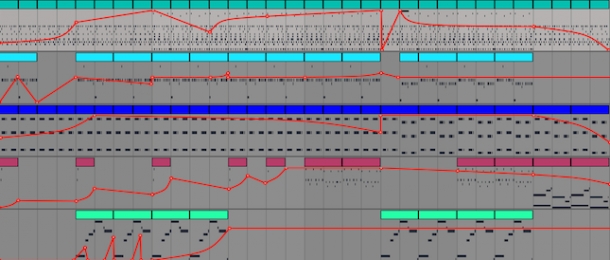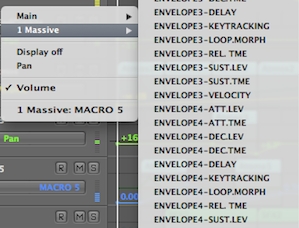
When I'm working on a new production, I usually build up the track fairly quickly using MIDI blocks and loops to get my ideas down quickly (before they vanish forever!). This also helps to give me a good early impression of how my arrangement is shaping up - every time I do this however, I always marvel at how dry and stale things sound at this very early stage of the production process. By the same token, I'm always equally amazed by how much more exciting and enlivened the music sounds when I move onto the next phase of my beatmaking workflow - adding automation.
Automation is without doubt one of the key ingredients in my music (and everything we do here at ModeAudio) and I would even venture to suggest it is one of the most important aspects in giving electronic music it's vibrancy and life. For those scratching their heads at dull, lifeless repetitions and relentless, inexpressive tones, automation is ready and waiting to be pulled into action in your favourite DAW and will introduce you to a whole new form of musically expressive power! I'm going to go through what I consider a number of vital uses of automation and hope they will give you some ideas about how to use it in your own music productions. Let's get started!
Automation 101 - Linear & Exponential Curves
To kick our voyage into the automated world off, I'd like to begin by talking about curves. Not those curves, dammit! Automation curves, to be precise. When it comes to working with most modern digital audio workstations, using automation means drawing in connected points along a timeline, known as a break-point envelope. The X-axis typically denotes time or bars, with the Y-axis specifying the value of the parameter you want to change (such as track volume).
So, automating in a music production context usually consists of choosing the desired parameter to be automated, selecting some form of a pencil tool and drawing in points along the timeline with your mouse. The points form a continuous line referred to as a curve (even if the line isn't curved itself), which can also be recorded in using external MIDI devices such as Novation's Launchpad, Ableton's Push, NI Maschine etc.

Audio Example 1:
If the value of the line between two interconnected points changes a uniform amount per unit of time along the X-axis, then this line is called a 'linear' curve. Listen to audio example 1 to hear a linear volume curve in action. This straight-line approach is by far and away the most common type of automation - however, most audio editing software such as Logic Pro and Ableton Live also allows you to make use of curved automation lines, which are called 'exponential' curves. Such curves can be used to slowly introduce a parameter change, with much more rapid changes occurring towards the end of the curve and vice versa - more of which we'll discuss below. Audio example 2 demonstrates an exponential volume curve - hear how the audio sharply crescendos at the end of the synth note, rather than the smooth increase audible in example 1'

Audio Example 2:
Volume Automation - The Big Fade
Now we know all about automation curves and what types we can use in our sessions and projects, let's take a look at how we can actually put them to use. I'd like to begin by examining the most fundamental music production parameter of them all - volume. The core element of mixing, automating track levels can help to direct the flow and energy of a track at the touch of a slider. For example, why not pull back the level of a synth pad at the beginning of the last bar before your big drop or chorus, ramping it up with a linear curve towards the end of the bar to direct your listeners' emotions towards your track's showpiece'
Volume automation also goes by two other names, both classic studio terms in their own right - the fade in and fade out. Just starting out with sampling and chopping up loops for the first time' Fades in and outs are your new best friends! Get rid of those ugly clicks and the abruptness of moving from silence to a full-formed sound by drawing in a smooth, linear volume curve at the beginning and then end of your audio region.

Another more advanced use of volume automation is to subtly ride the wave of emotion contained within a particular track, loop or region of audio, gently accentuating and enhancing the mood already contained in the audio file. Pro mixing and mastering engineers use this trick all the time to enhance the vibe and character of a vocal take for example, or to subtly direct attention towards certain notes or particular musical moments by giving their level a soft automation boost. We might term this 'micro automation', as opposed to the far more common 'macro automation' used over the length of a number of bars or entire sections of a song.

Panning Automation
Another music production parameter that is simply a joy to automate is panning. Panning literally moves the sounds in your track around the stereo field (assuming you're working in stereo with two speakers or headphone cups), so can work wonders in building movement and energy into your music. One of my favourite uses of panning automation is with transitional SFX, such as white noise risers and sweeps. Starting somewhere way out in the extreme left or right of the stereo field, I find that bringing a riser in slowly using an exponential automation curve towards the centre really helps to ramp up the mood of a track towards a new section.
I also find that panning automation works nicely for pads and gradual, evolving sounds of a similar nature. These sounds often have a drifting, slightly detached feel to them that works perfectly with slow, arcing movement through the air from speaker to speaker and back.
A word of caution - too much stereo movement can actually disorientate your listeners, as we're not generally used to sounds moving around too quickly from ear to ear. This is why film soundtracks, despite having access to 5.1 surround sound systems in the cinema, tend not to move the source of sounds around too much or too quickly - doing so risks making your entire audience feel more than a little queasy! So, keep your panning automation fairly gradual over time and use it sparingly.
Synth & Effects Parameter Automation
The next production area rife for the automating are effects and synth parameters. Of course, these are many and wide-ranging but it's worth pointing out at the very least, that virtually every parameter of a given VST plugin or soft synth is available for automation. In Ableton Live for instance, you simply have to click on a dial, slider or button in a given VST effect or synth to open up its automation lane in the arrangement view. In audio apps like Logic Pro or Pro Tools, you need to select your chosen parameter from a list of available options but, depending on the device of course, these lists are usually pretty lengthy!

Possibly the most classic use of effects parameter automation is with a low pass filter cut-off - how many times have you hear a nice, fuzzy synth chord progression begin in the bass and slowly open up to reveal all those gorgeous mid and higher frequency harmonics'! It's a definite cliché of electronic and dance music but it sounds great, is tried and tested and works (nearly) all the time. Hear this classic use of an automated low pass filter cut-off in audio example 3 below (the synth sound is taken from our Heatwave - Massive Synthwave Presets release).
Audio Example 3:
Now, what about taking that very same section of music you've added your filter cut-off curve to and automating the filter's resonance' Then, you could slowly ramp up the dry/wet control of a reverb unit to give the synth an even more open and expansive sound towards the end of the curve - are you starting to see how the possibilities are endless here'! Good!
Alternative Automation - Amps & Envelopes
We really could talk about automating every parameter of every audio effect and plugin under the sun but this would quickly turn into a textbook rather than a tutorial - the key is to boot up your DAW and get experimenting with the in-built devices and controls available within your favourite VST synths and audio FX. I'd like to suggest just one further use of automation that is a little off the beaten track but I find works really well with drum samples and percussion sounds.
If you use a sampler to construct your drum tracks, why stick with static envelopes and samples lengths for the entire duration of your tune' I find automating sample envelope lengths, particularly attack and release settings, really helps to contribute to a more organic and playful feel for drums - simply try subtly increasing the length of your sample release value during choruses or the emotional high points in your track to hear how this can work well in action. You can hear smooth, linear envelope release time automation occurring within the drum loop in audio example 4 below - I think this really helps to create musical momentum and energy, building up towards the end of the loop and next section of the track.
Audio Example 4:
The sky really is the limit as far as automation and music production go. Take a stereo tremolo plugin, take it out of 'sync' mode and automate the LFO time to produce quivering effects that ebb and flow with the mood of your music; automate the feedback of a delay device so that certain important notes blossom and decay in the swirl of your tune; gradually boost the drive control of your favourite distortion, fuzz or tube amp plugins to increase the tension as your synth riff powers on towards the chorus. In other words, get as creative as you want to and revel in the expressive power of music production automation!
A great way to learn more about automation and how to use it in your music is to look at pre-mixed and automated DAW sessions, such as those included in our House Generator - Ableton Live Racks pack. It contains 12 Live 9 demo sessions that are packed with the types of automation discussed above!













